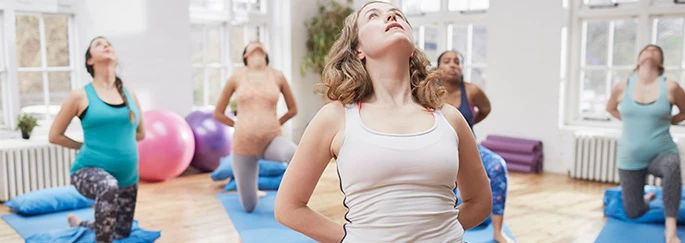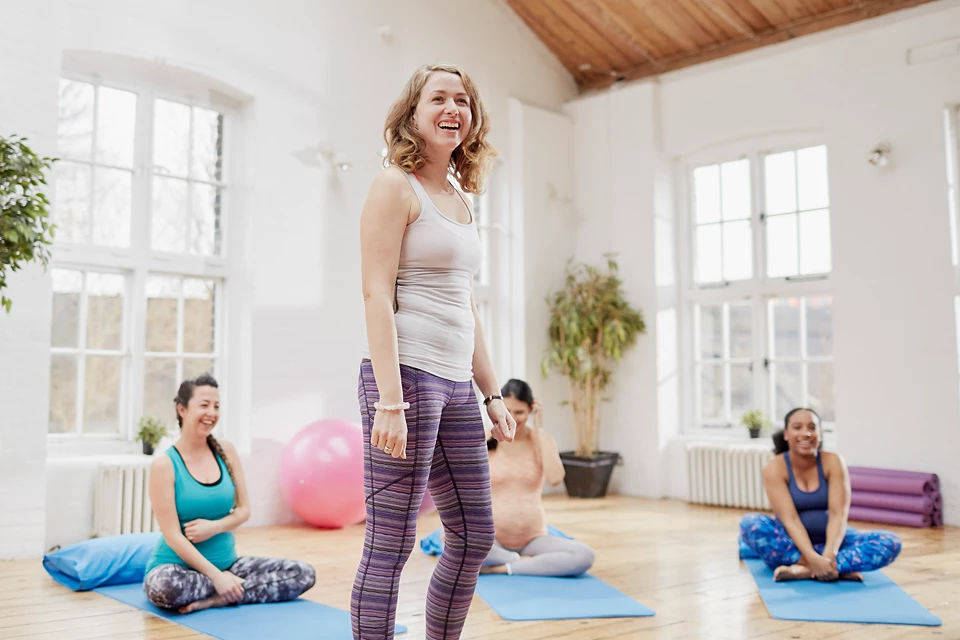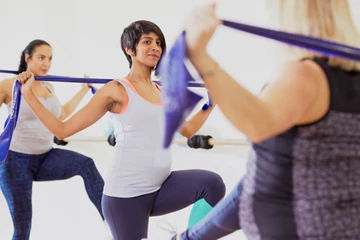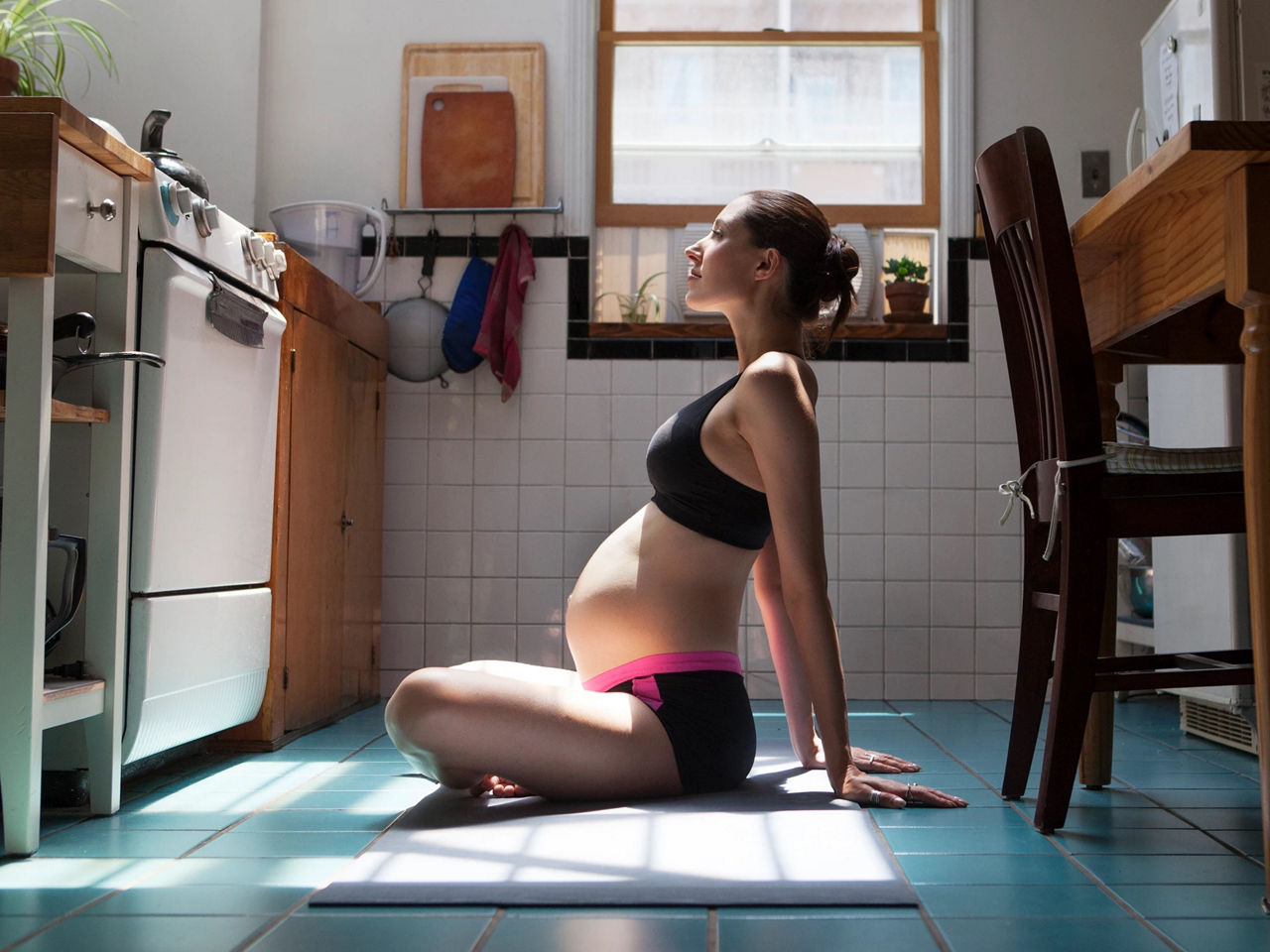Pregnancy yoga benefits
Pregnancy yoga, as with many pregnancy exercises, may reduce lower back pain1, tiredness2 and weight gain3. For your baby it could result in a healthier heart rate4 and birth weight5. Studies also show that prenatal yoga may even result in less labour pain, a shorter labour6 and a reduced risk of premature labour7. Yet Yoga Coach Clare believes it’s the mental benefits that mums feel the most; yoga gives them the time to come to terms with the many changes pregnancy brings, whilst readying themselves for labour.

Meet your coach
Clare Maddalena
Clare is a Yoga Teacher, doula, mother and owner of Lushtums – who specialise in pregnancy and postnatal yoga. She has taught over 5,000 women and practised yoga throughout her own pregnancy. Watch the video to find out why Clare is passionate about teaching mums how to get Active for 2 through yoga.

Pregnancy yoga exercises
What you'll need
Yoga requires little equipment – a blanket and cushions will do if you don’t have a mat or blocks. Keeping a water bottle to hand will help you to stay hydrated.
- A yoga mat – use a thick folded towel or blanket if you don’t have one.
- Cushions or pillows – for extra support.
- Loose, comfy clothes – layer up if the room is cold.
Pregnancy yoga routines by trimester
If you’re in your first trimester or you’re new to yoga, Clare’s first trimester practice is a great place to start. Her video features gentle, easy movements, which are ideal if you’re experiencing tiredness or morning sickness.
Before you start, read Clare’s advice on practising pregnancy yoga safely. Remember to listen to your body; if you feel faint or dizzy, stop. It’s important to work with your body rather than against it.
If you’ve practised yoga before or you’re in your second trimester and are feeling more energised, try Clare’s second trimester practice – which builds on the first trimester routine. It features more active, dynamic postures, with modifications if you’re still feeling queasy or experiencing pelvic girdle pain (PGP).
Before you begin, read Clare’s advice on practising pregnancy yoga safely. If you feel faint or dizzy at any time, simply stop. Listening to your body is key.
In your third trimester, you may be feeling heavier and more tired than before. Featuring deep, slow breathing exercises and floor-based, hip-opening postures, it can help to prepare your body for labour.
Remember to rest and pause whenever you feel the need, and listen to your body. If you prefer, you may like to return to the first trimester video for your practice.
Prenatal Yoga safety
- Always inform your midwife or doctor of your intention to exercise during pregnancy.
- Eat little and often to maintain your energy levels.
- Never hold your breath – remember to breathe deeply and continuously.
- Avoid lying on your back, especially after 16 weeks of pregnancy, as the weight of your bump can restrict blood flow and interrupt oxygen flow.
- Avoid overstretching. The pregnancy hormone relaxin can make you more flexible, so it’s important to protect your joints.
- Avoid inverted postures – those that position your heart higher than your head, such as headstands or the ‘downward dog’. These postures can cause compression of the placenta and interrupt oxygen flow.
- void bending backwards as this can compress the spine further and lead to lower backache.
- Move slowly and smoothly – whether you’re changing position or getting up or down.
- To get up from the floor, roll onto your left side and push yourself up with your right hand.
- Listen to your body. If it feels uncomfortable, either physically or mentally, take a break.
More sports

Need some help?
You can get quick answers to common questions in our FAQs.
Alternatively, if you need help with general pregnancy or baby advice, or maybe on using or ordering our products - our expert team are always on hand to talk about feeding your baby.
- Pennick V, Liddle SD. Interventions for preventing and treating pelvic and back pain in pregnancy. Cochrane Database Syst Rev 2013(CD0011):1-100.
- Gaston A, Prapavessis H. Tired, moody and pregnant? Exercise may be the answer. Psychol Health 2013;28(12):1353-69.
- Domenjoz I et al. Effect of physical activity during pregnancy on mode of delivery. Am J Obstet Gynecol 2014;211(4):401.e1-e11.
- May LE et al. Aerobic exercise during pregnancy influences fetal cardiac autonomic control of heart rate and heart rate variability. Early Hum Dev 2010;86(4):213-7.
- Bisson M et al. Physical activity volumes during pregnancy: A systematic review and meta-analysis of observational studies assessing the association with infant's birth weight. AJP Reports 2016;6(02):e170-e97.
- Chuntharapat S et al. Yoga during pregnancy: Effects on maternal comfort, labor pain and birth outcomes. Complementary Ther Clin Pract 2008 May;14(2):105-15.
- Narendran S et al. Efficacy of yoga on pregnancy outcome. J Altern Complement Med 2005 Apr;11(2):237-44.
Last reviewed: 3 June 2020
Reviewed by Nutricia’s Medical and Scientific Affairs Team




